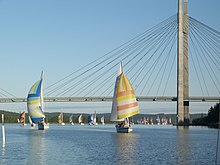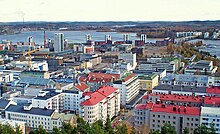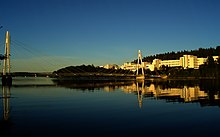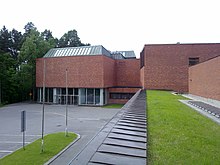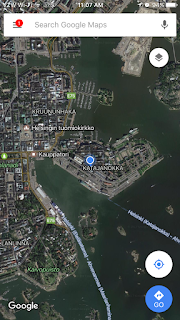If you scroll to the bottom of this post, I've pasted information from the website.
In the meantime, here are some pictures of our adventures:
The main doors of schools in Finland are unlocked and there is no main office to report to. However, every classroom door is locked and requires a key card to open.
Students stay with the same teacher from when they enter the school at age 7, to when they leave after 6th grade.
Students don't wear shoes in the building. I know! It seems so revolutionary, but makes such good sense. Don't you think better when your feet are free??
Every 30-40 minutes, students have a 15 minute break. They go outside and play. An adult or two loosely monitors the students; teachers and staff have break time.
 |
| There are many relaxing areas of the school where students can make themselves comfortable. |
 |
| Crafts look the same no matter what the country! |
 |
| I love the spiral staircase - it is beautiful, uses space well, and helps students learn to navigate politely. |
 |
| Not all classrooms are this modern. The 6th grade tour guides wish their classroom had wheelie chairs. |
 |
| Vivi enjoyed the semicircle seats. |
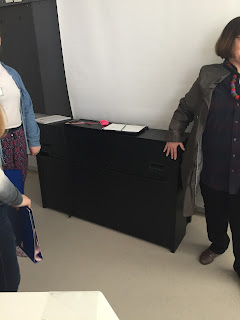 |
| Each room has a piano because music is seen as integral to education. |
 |
| A computer lab. |
 |
| Vivi loves this art project. |
 |
| Throughout the school, there are inviting areas for students to work. |
 |
| IKEA translates to schools beautifully! |
 |
| This special education classroom has a mirror so students practicing speech have a nice visual of themselves. |
 |
| What kid doesn't like bean bags? |
 |
| Benches are spread throughout the school so students can work in the classroom or elsewhere. |
 |
| The dragon sculpture on the right was given to the school as a gift a few years ago. (their mascot) |
 |
| Those are soft bleachers on the left and a stage in the center. |
 |
| I never knew bleachers could be soft. |
 |
| looms |
 |
| This area of greenery creates a calming place. |
After the school visit, we went to the University of Jyväskylä for my presentation. There is cool art throughout the buildings.
 |
| Apparently I will type incorrectly in every country because of different keyboards. |
 |
| Yep. Shoes. |
 |
| Riika's office |
 |
| Riika! She is a professor at University of Jyväskylä in their Teacher Training Progam and she sponsored my visit through Fulbright Finland. |
 |
| Let's pause for some Finland beauty. Finns take time to enjoy nature and spend time appreciating the quiet. |
 |
| The Marchetti Girls right before the presentation |
 |
| Mid-presenation |
 |
| I was so excited to talk about Full-Service Extended School and Community Use of Schoosl! |
 |
| With Riika and Tiffany, another Fulbrighter. |
 |
| Another pause for Finland beauty. |
 |
| Check out this sunset and breathe deeply. |
 |
| The air is just as clear and you'd think. |
As usual, Vivi and I were beat. We now wake up a little bit in the night and wonder what country we are in, so it was time to slow down a little. Back to the hotel we went so we could read and relax.
 |
| Vivi is reading a hilarious book about horrible children. |
 |
| and devouring chocolate whenever she can get her mitts on some. |
 |
| Finns like their kids and there are playgrounds and play areas and things for kids to do all over. |
 |
| It's a good thing we kept our eyes peeled for the bus stop. It wasn't a huge sign. |
 |
| The bus brought us to Tiffany! |
 |
| We walked around Jyväskylä and found a playground for Viv. |
 |
| Then took the bus back to the hotel. |
The hotel where we stayed had a magnificent pool with little alcoves with jets of varying pressure. There were several hot tubs with different temperatures, and there was a cold tub. And, of course, saunas. You can bet we spent a significant amount of time in the pool areas.
Next up:
Jyväskylä
to
Helsinki
to
Dublin
to
Belfast.
Wednesday is Vivi's birthday and visitors arrive in Belfast! Then we head out later that week for a trip to Switzerland to celebrate Viv's birthday in the Alps. I think that's our last trip until Edinburgh at the end of June, but I could be wrong.
Here's the information about Jyväskylä from Wikipedia:
Jyväskylä (Finnish pronunciation: [ˈjyvæsˌkylæ]) is a city and municipality in Finland and in the western part of the Finnish Lakeland. It is the largest city in the region of Central Finland and on the Finnish Lakeland.
Elias Lönnrot, the compiler of the Finnish national epic, the Kalevala, gave the city the nickname "Athens of Finland". This nickname refers to the major role of Jyväskylä as an educational centre.[7]
The works of the most famous Finnish architect Alvar Aalto can be seen throughout the city. The city hosts the Neste Oil Rally Finland, which is part of the World Rally Championship. It is also home of the annual Jyväskylä Arts Festival.
As of 31 March 2016, Jyväskylä had a population of 137,392.[3] The city has been one of the fastest growing cities in Finland during the 20th century.[8][9][10] In 1940, there were only 8,000 inhabitants in Jyväskylä. The Jyväskylä sub-region includes Jyväskylä, Hankasalmi, Laukaa, Muurame, Petäjävesi, Toivakka, and Uurainen.

In the Jyväskylä region, there are archeological findings from the Stone Age. According to the oldest available taxation documents (maakirja), there were seven estates on the Jyväskylä region in 1539. One of them, the estate of Mattila, alone possessed the areas stretching from the village of Keljo to the villages of Vesanka and Palokka. The oldest estate in Jyväskylä continuously held by the same family is the estate of Lahti, which emerged when the estate of Mattila was split between two brothers in 1600.[12] The history of the estate of Lahti and the family of Lahti have had a significant impact on the development of Jyväskylä region. Lahdenrinne, in the south-west corner of Jyväsjärvi lake, belongs to the old heartland of the estate of Lahti.[13]
The City of Jyväskylä was founded on 22 March 1837 when Emperor of Russia and Grand Duke of Finland, Nicholas I of Russia, signed the charter of the city and the infrastructure was essentially built from scratch.[14] At the times Finnish military battalion Suomen kaarti participated under his rule in military operations against the Polish November Uprising and later in Hungary, Turkey and Bessarabia (today Moldova). While Nicholas I of Russia abolished many autonomous areas, it has been argued, that the loyalty of Finnish military influenced his approach towards Finnish autonomy.[15] The original town was built between Lake Jyväsjärvi (which is connected to Lake Päijänne) and the Jyväskylä ridge (Harju), and consisted of most of the current grid-style city centre.
The establishment of schools in the 1850s and 1860s proved to be the most significant step in regards to the later development of Jyväskylä. The first three Finnish-speaking schools in the world were founded in Jyväskylä, the lycée in 1858, the teachers’ college in 1863, and the girls’ school in 1864. Well-trained teaching staff and pupils from different parts of the country changed the atmosphere of Jyväskylä irrevocably.[16]
In the early 20th century, the town expanded several times. Most of today's Jyväskylä was built after the Continuation War, when refugees from Karelia and other parts of the country moved to the city, and housing was badly needed. During the 21st century Jyväskylä has grown fast – by over 1,000 inhabitants every year.[17]
Säynätsalo was consolidated with Jyväskylä in 1993, and Jyväskylän maalaiskunta and Korpilahti, for their part, on January 1, 2009.
Geography[edit]
Jyväskylä is located on the northern coast of Lake Päijänne, 147 kilometres (91 mi) north-east of Tampere and 270 kilometres (170 mi) north of Helsinki. The hilly and forested terrain in Jyväskylä is surrounded by hundreds of lakes. To reach Jyväskylä from East, one needs to go through or pass the hill Kanavuori, which used to host a military depot full of ammunition and armaments. There is a train tunnel though the rock, which provides a scenic experience in otherwise relatively plain territory.
Jyväskylä is located in the Finnish Lakeland. There are 328 lakes in the city, and lakes and rivers constitute 20,1% (295 km2) of the total area of the city. The city's largest lakes are Päijänne, Leppävesi, Tuomiojärvi, Palokkajärvi, Luonetjärvi, and Alvajärvi-Korttajärvi. The city center is located on the shores of a small Jyväsjärvi.[18]
The landscape in Jyväskylä is hilly, forested and full of waters. The architect Alvar Aalto compared the hilly landscape of Jyväskylä to Toscana in Italy: "The slope of Jyväskylä ridge is almost like the mountain vineyards of Fiesole".[19]
Climate[edit]
Because of its northern location, winters are long, snowy, cold, and dark. During midwinter, the city receives daylight for only around five hours. Summers are mild, with the average daily maximum temperature being 22 °C (72 °F) in July. During the summer, Jyväskylä experiences long daylight and white nights i.e. midnight twilight.
Cityscape[edit]
Jyväskylä was founded in the northern end of the lake Päijänne at the crossroads of three major waterways. Lakes control the cityscape.[16] The city grid plan from 1833 by Jacob Leonard Boringh can be well recognised in the city center.[54] Nevertheless, due to very rapid population growth, the cityscape has gone through one of the most massive changes in all of Finland.[55]
Nowadays, Jyväskylä is a city of modern architecture. The city has more buildings designed by one of the best known international functionalist architects Alvar Aalto than any other city in the world.[56]
The establishment of schools in the 1850s and 1860s proved to be the most important step from the point of view of the later development of Jyväskylä.[16] The headquarters of the University of Jyväskylä are considered to be Aalto's masterpieces. Later, a modern architect Arto Sipinen, a pupil of Aalto, has influenced the cityscape since the 1970s by designing most of the new university buildings in the city.
The outskirts of the city are mainly populated by student apartments and single-family houses. Some of the most important buildings, like Säynätsalo Town Hall, designed by Aalto are located outside the city centre in Säynätsalo and Muuratsalo.
Consolidated areas Korpilahti, Jyväskylän maalaiskunta, Säynätsalo and also western parts of Jyväskylä are mainly countryside dominated by hilly forests and lakes.
Education[edit]
Jyväskylä is a traditional centre of education. Including school children, and the students in high schools, vocational schools, the university of applied sciences, and the universities, the number of students and pupils in the city reaches 45,000, boosting Jyväskylä's reputation as a "student city". Over 30% of the city population are students.[57] A number of firsts in Finnish education have taken place in Jyväskylä:
- Jyväskylä Lyceum (Finnish: Jyväskylän Lyseon lukio) is the world's first junior secondary school with Finnish as the language of instruction.[citation needed] It started its first term on 1 October 1858. Lyceum still exists and is one of the nine upper secondary schools in the city.
- The first Finnish-medium teacher training college (1863)
- The first Finnish-medium school for girls (1864)
- Finland's first Summer University (1912)
Due to this, among other things, the city has earned the nickname Athens of Finland. The teacher training college later evolved into the College of Education (1934) and further into the multidisciplinary University of Jyväskylä (1966).
The University of Jyväskylä is one of the most popular universities in Finland. Almost 16,000 students are enrolled to study for a bachelor's or master's degree, and the university also offers PhD programs in most of its subjects. Historically, the university has excelled in the study of education, but in the last few decades it has also gained respect in the sciences. It is the only university in Finland offering university-level education in sports, training sports teachers and coaches. Today the University offers also Cyber Security degrees, in close co-operation with the Finnish Defence Forces.[58] According to the Ministry of Employment and the Economy the city has been acknowledged in 2013 as the Cyber Security City, providing a portfolio of Cyber Security related studies and activities.[59]
JAMK University of Applied Sciences has 8.000 students. It has four different units: School of Business and Services Management, School of Health and Social Studies, School of Technology and Teacher Education College.[60] HUMAK University of Applied Sciences educates cultural management in Jyväskylä.








